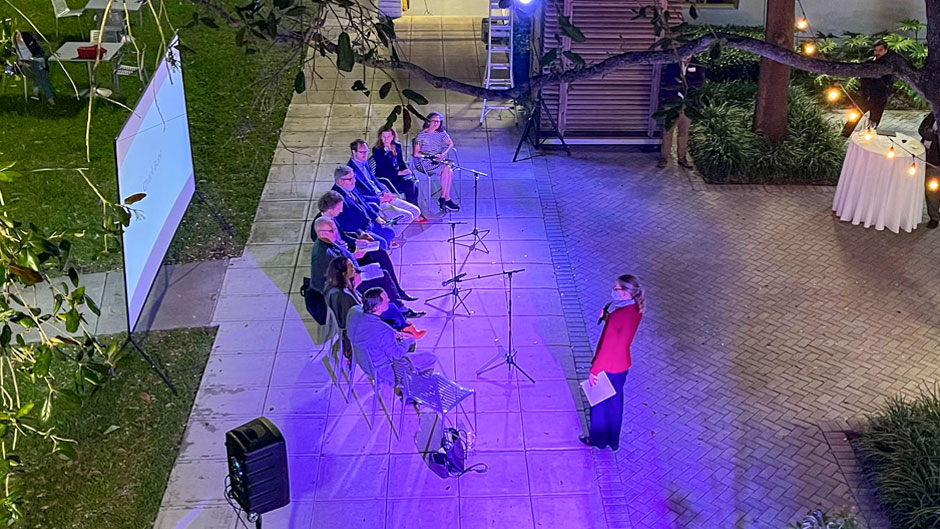How does Miami-Dade County prioritize the need for resilient projects throughout the county?
How has the COVID-19 pandemic changed the real estate market in South Florida?
What kind of building materials can be used to withstand the ravages of climate change?
All these are issues relevant to University of Miami School of Architecture students and many others in the University community. That is one of the reasons why the school has launched a series of gatherings to highlight its graduate programs as well as the research being carried out by faculty members and students.
These salons—the brainchild of Sonia Chao, research associate professor and associate dean of research—offer an informal gathering spot to exchange ideas and network.
“It is an opportunity to come together as a community to discuss issues that we know to be relevant not only to our profession but also to all of those we engage with across disciplines and in our region and to highlight interdisciplinary investigations and actions,” Chao said. “These are occasions to celebrate current research endeavors while we reconnect or connect with our peers, students, alumni, and community.”
The salons are held outside in the courtyard of the school every Thursday in February, beginning with a reception at 6 p.m. The gatherings are open to the University community and the public.
The first salon, held on Feb. 3, was curated by Elizabeth Plater-Zyberk, director of the master of urban design program, the oldest graduate program at the school. Many of the participants were professors who had taught in the program.
“I hope the students will have a new understanding of the field, how it ranges from the large scale of planning to the detail of architecture, and that the specifics of urban design—buildings and public spaces—can have a powerful influence on social and environmental concerns,” said Plater-Zyberk.
Among the faculty members teaching urban design are a significant number of researchers and scholars whose publications are renown, she said, and librarian Gilda Santana had set up a table to exhibit many of them at the event last week.
This week, Armando Montero, director of the construction management program, will lead a “What is the future of architects in construction?” session. It will highlight the work of the program with contributions from a panel that includes five of its faculty members, a representative from local government, and professionals in practice—including Stefan Chin, partner of Peckar & Abramson, and Jane Decker, director of the City of Doral building department. The School of Architecture’s new graduate program director, Joel Lamere, also will be part of the panel discussion.
Chao, who is also the co-director of the new interdisciplinary Master of Professional Science (MPS) in urban sustainability and resilience program has curated a panel for Feb. 17. “What does building resilience entail?” will be addressed. Chao has invited MPS students to moderate the session, as well as several members of the community who have worked with her on research projects and who co-teach with her. Among these are architect Jaqueline Touzet of Touzet Studio and Katherine Hagemann, resilience program manager for adaptation of the Miami-Dade County Office of Resilience. Tim Norris from the Institute for Data Science and Computing and professor Louis Herns Marcelin, director of the MPS in global health studies, will round out the panel.
There will be a small exhibition highlighting initial student research in the county’s Little River Adaptation Action Area—where the county is attempting to curtail sea level rise in one of the most vulnerable areas in Miami that is prone to flooding.
Students in the urban sustainability and resilience program are also working with Norris, a data scientist in University Libraries. He is guiding them and facilitating their use of an app Chao has edited to gather building and urban data, which in turn informs her research about the vulnerability of the terrain in the Little River area—part of her newly awarded U-LINK grant.
The last salon of the month, “What has been the impact of COVID-19 on South Florida real estate and what does its future hold in the pandemic era?” will be held on Feb. 24. It will be co-curated by Chuck Bohl, professor and director of the graduate program in real estate development and urbanism and Mark Troen, lecturer in the same program, and will highlight student research.
Two other initiatives have been created by Chao to increase the knowledge of research and creative work being carried out at the school as well as to nurture their growth. An internal monthly newsletter was launched in September providing School of Architecture faculty members and students with links to research, articles, competitions, workshops, and grant opportunities.
In the coming months, a new online portal will be available on the School of Architecture’s website, and it will highlight and make more readily accessible faculty research, peer-reviewed publications, exhibitions, and creative work.

